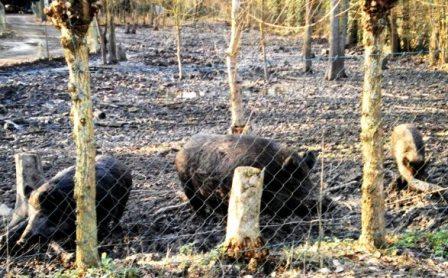The wild swine (wild (boar), feral pig, wild hog, razorback, Sus scrofa).
Differences between a (tame) pig and a (wild) boar:
tame pig wild boar
short snout long snout
curly tail tail with a brush
teeth large tusks
little hair long hard hair
ears forward straight ears
gray or pink skin brown to black
 This impressive muscle mass has earned its own jargon, but my limited knowledge of English is clearly insufficient to find the right words, as they should exist:
This impressive muscle mass has earned its own jargon, but my limited knowledge of English is clearly insufficient to find the right words, as they should exist:
rut: bone time (literal translations!)
boy (the first year, from 30 kg): sucker, (piglet)
older boy: shoat, (boarlet)
pubescent male: hog or tusker
adult female: sow (or?)
swine herd: sounder, drift
wildlife: wild boar or razorback
tusks of wild boar: hewers (choppers) or guns
Pliny mentions that the crossing of domestic and wild pigs was no problem. The tame were perhaps a little wilder than their current counterparts.
Wild boars have a stocky body and an elongated head. They have a moveable, flattened snout. The lower canines of wild boar grow tusks upwards and outwards. The upper canines grow too, allowing them to make a U-turn.
Length of the animal is 100-167 cm, shoulder height of 70-115 cm and weighs 35-185 kg. Males are larger and heavier than sows. The record weight is 230 kilograms.
The tail is 15-25 cm long. The maximum age is 30 years, in the wild 8 to 10 years.
From the head down to the tail runs a back stripe extra long hair, that stands upright when they are angry or frighty which makes the razorback looks more threatening.
Smell and hearing are highly developed. Just think of the pig as a seeker of truffles (underground mushrooms). However, the vision is poor.
Wild swine are omnivores. They live mainly in deciduous and mixed forests where they coveted 'mast‘: find acorns and beech nuts. They do not have a rooting snout for nothing. Their food is found in the soil: roots, tubers, truffles, insect larvae, worms and snails, but also grasses, eggs, lizards, snakes, frogs, mice, young rabbits, birds and deer, carrion and fruits they eat.
The mating season from early November to February is a turbulent period in which the older males can pummel each other with quite a lot of noise.
The sow burrows with her muzzle a pit in the ground and cloths it with ferns, leaves and moss. Then they cover the hole again with a sort of roof structure of branches, ferns, moss, grass and leaves, like masonry hold together with saliva. They let this semicircular kettle open on one side.
The gestation period is between 114 and 140 days.
The number of piglets per litter is 3 to 7, sometimes to 12. The sows can have 12 (or more) nipples. Each has its own big nipple, which in the early days is won by vicious fighting factions. The piglets have the first three, four months, an orange brown striped pajamas. They can see immediately after birth.
They are weaned at 4 months, but starting after 14 days of eating plants and insects.
In February, the sows leave their young and are rutting again to be covered.
In the 2nd year young boarlets remain mostly socially close to each other.
After the second year of life, the males live alone on a fixed territory and they stay away from the family groups.
The sows live in well ordered sounders and remain in their territory.
They are eminently night and twilight animals. For their wanderings they use fixed trails, worn paths, which run from cover to cover.
During the day, they like to lie in dense shelter where they have scoured deep forms or day nests.
They like to wallow (daily) in mud, let it dry and then rub their skin against trunks or stumps to get rid of the mud and therein trapped ticks, lice and fleas.
Watch out for sows with suckers or shoats (little ones). If they think that the piglets are threatened they can be dangerous. Also a wounded animal is dangerous.
" Pol! ‘"Yes?" " Everything okay?" "Yes!" "All right, then I still got that wild boar! " (JW Besouw)
